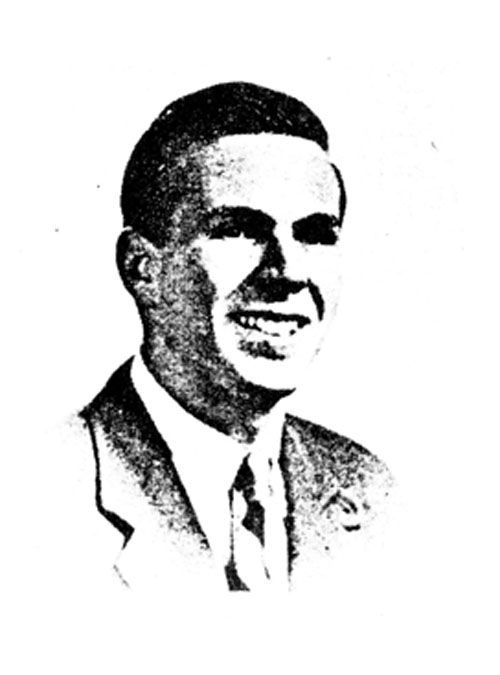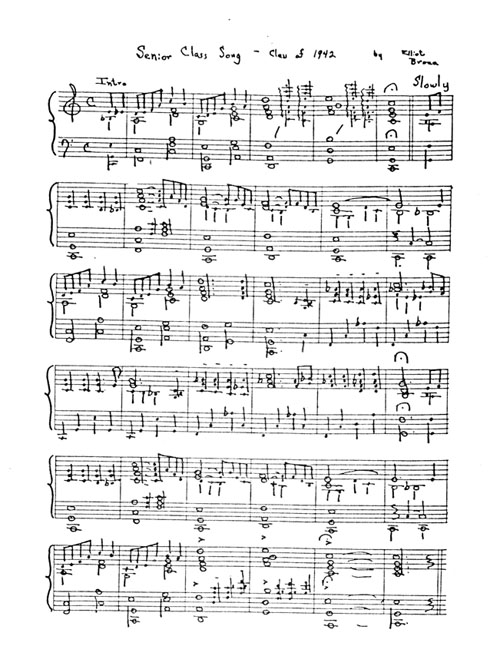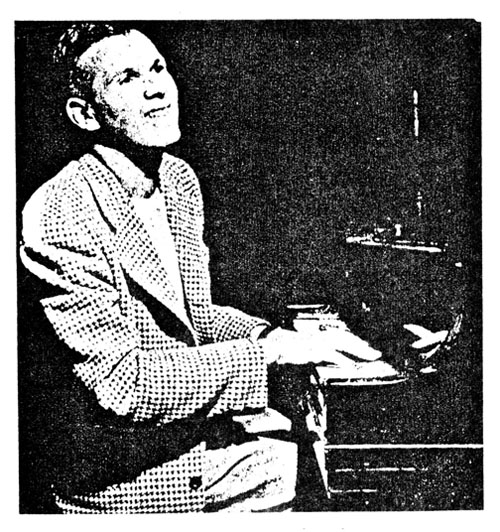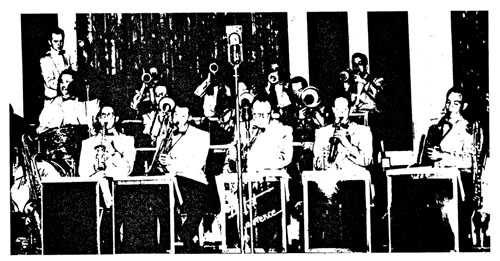|
Home : Quarterly Archives : Volume 20 |
Tredyffrin Easttown Historical Society |
|
Source: July 1982 Volume 20 Number 3, Pages 87–94 From T/E to CBS : Elliot Lawrence In the class prophecy for Tredyffrin-Easttown High School's Class of 1942, it was predicted that on "August 3, 1948 .. . at three o'clock, we tuned in the radio to listen to Elliot Broza's orchestra, ... " If the predicted time had been nearer to eleven thirty at night, it might have happened - for Elliot Lawrence Broza, by then known professionally simply as Elliot Lawrence, had been a part of the country's "big band scene" since 1946. The Brozas lived in a large 28-room house on the northeast corner of Sugartown and Fairfield roads, having moved to Devon in 1936. Stan Lee Broza was general manager and program director for radio station WCAU in Philadelphia, and since 1928 had been producer and director of its popular Children's Hour program, broadcasted on Sunday mornings. Esther Broza, his wife, was a script writer for the program, and also auditioned many of the children before they appeared on the show. Born in Philadelphia on St. Valentine's Day in 1925, Elliot Broza from the age of two was fascinated by the piano. At four he began taking lessons. His first teacher, Louise Rebe, knew immediately that "Elliot had something special", though she admitted she was not "quite sure what". His piano practice also became therapy a few years later, when he was stricken with infantile paralysis. His first composition, "Falling Down the Stairs", was written when he was six, but even the author agreed that it had some shortcomings. A few years later Elliot Broza was also playing the saxophone. After the family moved to Devon, he took lessons from Stanley Gray, the music director for the Tredyffrin-Easttown school system, also doubling on the clarinet. It was at about this time that the "Band Busters" was organized. An eleven piece dance band made up of children between eleven and fifteen years old, the band used the third floor of the Brozas' home in Devon as a rehearsal hall. The group not only played on the Children's Hour program, but also at private parties for which the young musicians were paid from a dollar and a half to three dollars each. In addition to playing piano, saxophone and clarinet in the band, Elliot Broza was its business manager, arranging bookings and handling all the band's correspondence. (Among the other players in the group was Buddy De-Franco, who later played clarinet in the bands of Charlie Barnet, Tommy Dorsey, and Gene Krupa.) A promoter from the west coast had big plans to promote the group - until he discovered that with their maturity and poise they could easily have passed for high school seniors, and that the "children's band" in no way resembled the "Our Gang" characters he had apparently expected them to! With this background, it was inevitable that as a student at Tredyffrin-Easttown High School, Elliot Broza would be involved in just about everything pertaining to music, instrumental and vocal. And he was. Even when he was in ninth grade, Stanley Gray has recalled, there was an occasion when it was necessary for him to step into the lead part of the operetta being given. He took over the part on just two days' notice when the original lead became sick, Gray reported, and was "letter perfect" by dress rehearsal. ("He couldn't really sing," Gray also later recalled, "but his musical sense was such that he could get away with it.") He was also drum major of the T-E marching band all four years that he was in high school. He worked hard to maintain school spirit and morale at a time when it was not particularly easy, since in both his sophomore and junior years the football team was without victory, though it did manage a scoreless tie in one game during his junior year. The Brozas even lent their pet bulldog, Jiggs, to the cause as the team!s mascot - but for only one year as Jiggs spent each weekend that fall at the veterinarian's, undoing the effect of all the hot dogs his fans had fed him during the game! Broza was also student director of the orchestra all four years, and a member of the South Eastern orchestra and All State orchestra in his sophomore, junior, and senior years. In these same three years he was also a member of the South Eastern and All State bands. And he also played in the T-E Swing Orchestra. In his sophomore years, he won first prize in the statewide competition held each year by the Penn State Music Association. Notwithstanding Stanley Gray's observations on his singing ability, he was also a member of the chorus and Candlelight Procession in all four years he was in high school, of the A Capella Choir in his senior year, in the operetta two years, and sang in the Cantata his sophomore year.
Elliot Broza, Academic, Decon, Pa, from the 1942 Yearbook As the accompanist during the rehearsals for the school's production of "H.M.S. Pinafore", one of his fellow students, Grace Kugler (Winthrop) has recalled, he would occasionally inject a rhythm not altogether Sir Arthur Sullivan's into the music. Subtly, the score was soon transposed and rearranged into a swing or jazz version of the operetta: one night Stanley Gray actually broke his baton trying to get the music back to the original version. Another student, Bill Brosius, has recalled that he "was generally considered to be Gray's right hand man in all things musical, despite the fact that he was only a student, ... I remember once, when Mr. Gray was out of the room during a band rehearsal, Elliot was telling us how he wanted the staccato notes played - quick, a sharp attack, no lingering whatsoever. A little later Gray came back and took over. After hearing our snappy staccato notes, he began a five minute lecture on how staccato notes should have a little bit of sustained tone, not too quick or sharp in manner. Elliot was standing behind Gray, shaking his head negatively, waving his hands in mock disgust and generally making it quite clear he completely disagreed - but at the same time he had a grin on his face for he knew whom we'd have to listen to." Not only was Broza voted "most musical" by his classmates his senior year, but also the boy student with "most personality", in spite of the fact that he was one of only a few students, according to Philomena Donato (Vallese), who wore a suit and tie to school almost every day. He was later described by Bill Brosius as "good natured, but with a sense of purpose around him".
As we leave these dear old walls
In these momentous times,
And now we say good-bye At the commencement exercises, he played Edvard Grieg's "Wedding Day" as a piano solo. He also wrote the words and music for the Class Song, And he was an honor student, too. While he was in high school, Broza also studied with William Happich, a prominent teacher of musical theory, with Robert Elmore on the organ, and began his studies with the composer-concert pianist Erno Ballogh. After graduation from Tredyffrin-Easttown, Broza entered the University of Pennsylvania, completing his course in a war-accelerated program in three years. His musical accomplishments at Penn were similar to those at T-E, as he won both the Alumni Prize in Music and the Thornton Oakley Gold Medal for achievement in creative art, only the second time in the history of the University that it had been given in the field of music. His winning original tone poem was later introduced by the Philadelphia Orchestra. He was also a member of the Glee Club, sang and played in two Mask and Wig productions, including a performance in "Red Points and Blue" for which he was elected a permanent member of the Club, and led the University's marching band. The band's jazz arrangements of traditional marches and football songs, as it marched down Franklin Field at half-time, even received press notice along with the writeups of the games. (His ear for music, however, was better than his ear for language. On one occasion, his mother has recalled, his French teacher became so exasperated with his faulty pronunciation that she literally threw the book at him!) Among Broza's music teachers at the University was Harl MacDonald, the Dean of Music, and a composer. He also studied in New York with Leon Barzun, conductor of the National Orchestra Association, and one of the leading teachers of conducting; in fact, Barzun was so impressed by his work that he offered him a job as his assistant. Immediately upon graduation from Penn, however, Broza took over as the musical director of station WCAU, where he put together what George T. Simon, music critic and editor of Metronome magazine, described as "the greatest studio band in the country". The band, Simon reported, "had a great deal of rhythmic sparkle, some of it attributable to the scores ... and some to the tremendous drive of the trumpet section. Everything the band played sounded musical," he wrote, "for Lawrence [as he was by then known] was an expert conductor." In the band, which sometimes practised in the I.A.C. Hall in Devon, were five alumni of the old "Band Busters". Billed as "Elliot Lawrence, his Piano and his Orchestra", the band was featured on a program "Listen to Lawrence" on WCAU, but its popularity soon earned it a spot on the national CBS network. In less than six months the program received more than 100,000 "fan letters". It was in early 1946 that Elliot Lawrence decided to take the band "onthe road" and enter into the big-band field. He opened at the Cafe Rouge in the Hotel Pennsylvania in New York City, his father having resigned from his position at WCAU to become the band's manager.
Elliot Laurence, his piano ... and his orchestra The band included a four-man rhythm section of piano (Lawrence), bass, guitar, and drums, three trumpets, three trombones, and five saxophones, to which Lawrence added an oboe and a French horn. At times, he also included a bassoon and English horn for additional coloring. Unlike many of the big bands, there were few outstanding soloists. It was the band!s arrangements, many of them by Lawrence, and it s overall musical quality that brought it recognition, a style developed only after Stan Kenton had advised Lawrence "to adopt his own style and stay with it". Other arrangements for the band were scored by Gerry Mulligan, later to become known in jazz circles for his baritone saxophone play, while Lawrence also commissioned other young musicians, including Johnny Mandel and Al Cohn, in addition to Mulligan, to do scores for the band. Using his own composition, "Heart to Heart", as his theme song, "Elliot Lawrence, his Piano and his Orchestra" played at such spots as the Cafe Rouge; Frank Dailey!s Meadowbrook; the Steel Pier at Atlantic City; the Hotel Sherman in Chicago; and the Palladium in Hollywood. In many cases remote radio pick-ups gave the band additional publicity and added to its reputation. The band also played theater dates in places like the Paramount Theater in New York and the Earle Theater in Philadelphia.
at the Palladium in Los Angeles Unfortunately, it was just about at this time that the "big band" era was coming to an end. Nevertheless, Lawrence continued his band, with changing personnel. Doing television and studio work during the week, he played concerts and at dances, generally at schools and colleges, on weekends. But after seven years, the economics of the business, the long distances between bookings, and his own health forced him to give up the traveling. Returning to studio work for CBS in New York City, Lawrence became the musical director for several television shows, including the "Red Buttons Show", and a number of television "specials", among them both the Emmy and Tony Award shows, and the special "'S Wonderful" tribute to George Gershwin and his music. In 1955 he married Amy Bumin, a graduate of Vassar and the Sorbonne. A quartet of children followed, all of them artistically or musically inclined: Alexandria in ceramics, Daniel on drums, Jamie on piano and cello, and Marianne in ballet and drama. The Lawrences' brownstone on East 91st street in New York, his mother has suggested, was just a continuation of the Brozas' third floor in Devon! Following a trip to Russia with Ed Sullivan, Lawrence was named the musical director of the Broadway hit "Bye, Bye Birdie" and was later also the musical director for such shows as "How to Succeed Without Really Trying", for which he won the coveted Tony Award, "Golden Boy", "Sugar", and "Here's Love". He was also musical director for a number of movies, including "The French Connection" and "Network", while his commercials for the Bell System, "Good Friends are for Keeps", won him a Clio Award. During the Bicentennial celebration, he also composed the score for the outdoor pageant "The Ballad of Valley Forge," and for "Independence", the film shown at the Visitors Center at Independence Hall. "Even though we live in New York," he was quoted as observing on one of his visits to Philadelphia, "my hometown in still Philadelphia. ... It's a good feeling - standing in the pit and having someone come up and say, "Remember me from junior high school?" - recalling when one of the top musical directors and a former big band leader was a student at Tredyffrin-Easttown. TopSources Conversations and correspondence with Esther Broza, William Brosius, Stanley Gray, Grace Kugler Winthrop, Philomena Donato Vallese
Clippings from the Philadelphia Record, the Philadelphia Daily News
Yearbook of the Class of 1942, Tredyffrin-Easttown High School
George T. Simon: The Big Bands New York, MacMillan, 1964.
Columbia Records: prsss releases and album notes
Program for "The Ballad of Valley Forge" |



